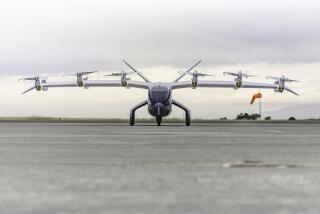Seattle Cruise Firm Airs Plans for 3-Day Space Junkets : $1-Million Far-Out Tourist Flights Seen
WASHINGTON — A decade or so hence, if you have a yen for adventure and $1 million burning a hole in your bank account, you just might be interested in buying an inaugural-flight seat on a three-day, 48-orbit tourist space flight around the Earth.
Plans for such junkets were aired Friday by Society Expeditions, a Seattle cruise company that currently offers deluxe tours of exotic places like Antarctica and offbeat Pacific isles at $15,000 to $30,000 a person. It said in a press release that it seeks to recruit “passenger/astronauts” who are “educated, well-traveled, adventurous and affluent.”
Society Expeditions President T. C. Schwartz told a news conference that the company expects it will have to charge $1 million a seat for the first flight, expected about 1995, but that it hopes eventually to lower the rates to about $50,000--provided a few obstacles can be overcome.
Prominent among them is the question of approval by the National Aeronautics and Space Agency of a proposal that NASA’s space shuttle be used as the vehicle, at least for early flights. Schwartz said the firm had initiated talks with NASA about the feasibility of a plan to have a 24- to 32-passenger module carried aloft in the shuttle’s cargo bay.
“We have received a lot of encouragement from NASA,” Schwartz said. “But we by no means are limited to one type of hardware.”
A NASA spokesman, who asked not to be quoted by name, said there has been informal discussions with the firm, but added that it is one of three commercial space companies with which NASA is talking.
Schwartz, meanwhile, said his firm also has initiated discussions with leading aerospace manufacturers about using “one of several different passenger-carrying vehicles now in their conceptual stages.”
Reservations from prospective space tourists will not be accepted “for quite a way into the future,” Schwartz said. He said consultants have advised the firm that a passenger module can be developed and test-flown by the mid-1990s.
If this schedule holds good, Schwartz said, the firm hopes to undertake three to five flights a year and “to eventually move 300 passengers a year into space.” In addition to their fares, pioneer passengers will be expected to be in good physical condition, be able to pass “a moderate physical and psychological screening process,” and to complete an “intermittent” six-week training program.
Reminded that Sen. Jake Garn (R-Utah) suffered from space sickness for two days aboard the last flight of the space shuttle Discovery, Schwartz said the problem of space sickness is now under study and “medication is being worked on.” It should not pose “any particular problem,” he said.
More to Read
Inside the business of entertainment
The Wide Shot brings you news, analysis and insights on everything from streaming wars to production — and what it all means for the future.
You may occasionally receive promotional content from the Los Angeles Times.










